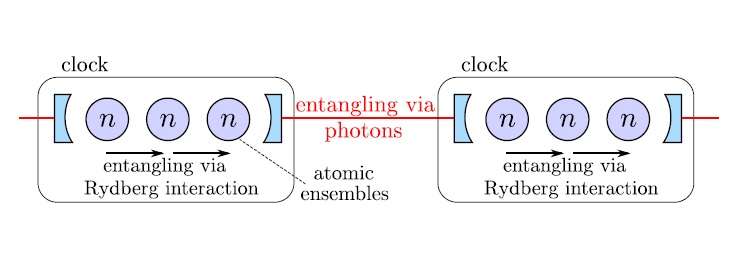August 19, 2016 feature
Method to entangle thousands of atoms could lead to record clock stability

Physicists have proposed a method for entangling hundreds of atoms, and then entangling a dozen or so groups of these hundreds of atoms, resulting in a quantum network of thousands of entangled atoms. Since small bundles of these entangled groups can function as atomic clocks, this design is the first detailed proposal for a quantum network of atomic clocks.
The scientists estimate that, if realized, these clocks will have an order of magnitude greater stability than today's best atomic clocks. Superstable clocks are critical for measuring astronomical effects such as gravitational waves and, potentially, dark matter.
The scientists, Peter Kómár et al., have published a paper on the proposed quantum network of atomic clocks in a recent issue of Physical Review Letters.
Currently, the most accurate atomic clocks have cores that are made of ytterbium or strontium atoms. Their "fractional frequency stability," which is a measure of the time difference between ticks, is just 10-18. That means that these clocks are stable enough that, if they started ticking at the beginning of the universe (13.8 billion years ago), today they would be off by less than a second.
In general, the larger the number of atoms in an atomic clock, the more stable it is. In the new study, the researchers showed that entangling the atoms in a clock further increases the clock's stability.
Their proposed protocol consists of five steps, which involve using single-photon pulses to entangle the atoms within each individual ensemble, and then interfering the pulses from two neighboring ensembles to entangle the ensembles. Eventually, entanglement spreads to all ensembles in the network, resulting in a fully entangled state of many thousands of atoms.
"Our work shows that utilizing remote entanglement to improve the accuracy of measuring time is within the reach of current experimental technology," Kómár, a physicist at Harvard University, told Phys.org. "This result will most certainly encourage further efforts towards constructing a prototype atomic clock quantum network, finding even better implementations and discovering new use cases."
The researchers showed that it should be possible to experimentally realize this network of atomic clocks using neutral ytterbium atoms. Even when accounting for errors and physical imperfections, they predict that the entangled atomic clock network will have significantly better stability than non-entangled clocks, making them capable of measuring relativistic effects in the passage of time.
"Superstable atomic clocks allow scientist to measure minuscule changes in the speed of passing time," Kómár said. "Although local time always passes with the same rate for the local observer, time often passes with slightly different rates at different locations. Many physical phenomena can cause the passage of time to slow down or speed up, all of which are tied to large masses and gravity."
By taking advantage of this relationship between mass, gravity, and time, researchers can use it for practical purposes, such as searching for underground oil reserves or gravitational waves in space.
"If the rocks under a particular spot are denser compared to the rocks under another spot, then time passes more slowly at the former location," Kómár said. "By installing two superstable atomic clocks at the two locations, and comparing their signal, one can measure this small difference in the rate of the passage of time—and, in turn, discover hidden ore or oil deposits beneath the ground.
"Gravitational waves is another phenomenon that causes time to pass at different rates at different locations. A formation of satellites, each equipped with superstable atomic clocks, can be used as a very precise 'space-seismograph.' As the gravitational wave passes through the region occupied by the satellites, their clocks pick up a tiny time difference with respect to each other. This provides a way to detect gravitational waves through the distortions of time as opposed to distortions of space, the method LIGO relies on, providing complementary means of detection."
In the near future, the researchers plan to pursue some of these applications of the entangled network of atomic clocks.
"There are already theoretical proposals and drafts on their way assessing the sensitivity of atomic-clock-based gravitational wave detectors," Kómár said. "Although these require the network to be constructed in space, near future experiments will most likely focus on lab-based and ground-based implementations. Only when the design is perfected will the clocks go on board of satellites."
More information:
P. Kómár et al. "Quantum Network of Atom Clocks: A Possible Implementation with Neutral Atoms." Physical Review Letters. DOI: 10.1103/PhysRevLett.117.060506
Also at arXiv:1603.06258 [quant-ph]
Journal information: Physical Review Letters
© 2016 Phys.org



















